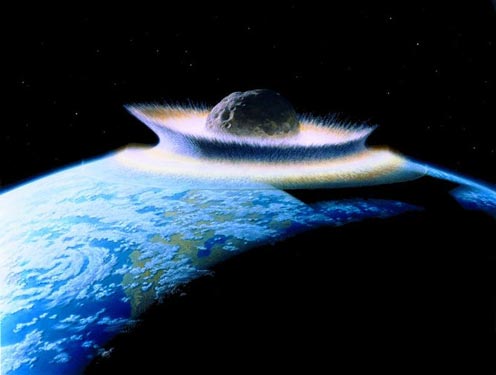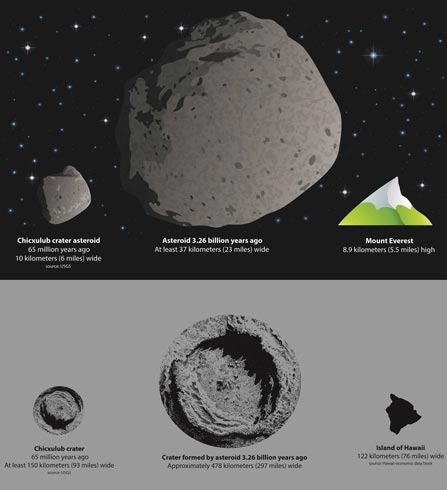Huge Extraterrestrial Impact that Shaped Our World
Impact Earth 3.26 Billion Years Ago
Scientists have discovered tell-tale signs in the geology of Earth which reveal a catastrophic ancient impact event that would have dwarfed the dinosaur killing asteroid of sixty-five million years ago. Approximately, 3.26 billion years ago, the region we now know as South Africa was hit by a colossal rock from space, a rock that would have been at least three times the size of the space rock responsible for the Cretaceous impact event.
Huge Extraterrestrial Object
Such was the magnitude of the impact that the Earth’s crust shifted, giving rise to some of the tectonic features that are still found today.
The study, published in the academic journal “Geochemistry, Geophysics, Geosystems” focuses on the geological formation called the Barberton greenstone belt in South Africa. This formation can be found in the north-east of South Africa and it partially borders the sovereign state of Swaziland. The rocks are mainly continental and consist of some of the oldest continental crust rocks known. The research team examined the seismology of the region and they estimate that between 3.47 billion and 3.23 billion years ago the area was the site of a massive impact from outer space.
Huge Extraterrestrial Object Crashes into Earth Around 3.26 Billion Years Ago
Picture Credit: Don Davis commissioned by NASA
The “Late Heavy Bombardment”
During that time in the formation of the Earth and the solar system, our planet had cooled sufficiently for oceans to form and primitive bacterial thrived, although at the time there was very little oxygen, the most significant gases in the atmosphere were nitrogen and carbon dioxide. The impact event occurred after the “Late Heavy Bombardment – LHB” which was a period of several hundred million years ending around 3.7 billion years ago when the inner rocky planets and satellites of the solar system was bombarded by space debris, left over from the creation of the planets and other bodies that make up our solar system.
Giant Space Rock
The space rock, perhaps an asteroid or even a comet from further out in the solar system crashed into Earth. The object measured between 37 and 58 kilometres across and smashed into the region of southern Africa at a speed of more than 20 kilometres a second (a speed of around 43,000 miles an hour). The crater caused would have measured over five hundred kilometres in diameter (300 miles), although this has been eroded away. The resulting impact sent seismic waves through the entire planet and it is likely that these seismic waves exceeded the amplitudes of typical earthquake waves. The duration of extreme shaking was also far longer, probably hundreds of seconds, than that from strong earthquakes.
Debris Ejected into the Atmosphere
Debris thrown up into the atmosphere would have sufficient momentum to leave the Earth’s orbit, firestorms would have ravaged the planet and tsunamis hundreds of metres high would have smashed into the nascent continents. Indeed, water at the surface of the oceans would have been boiled away. Such was the force generated that subduction might have occurred as a result, helping to shape the continents.
Geologist, Donald Lowe of Stanford University and a co-author of the scientific study explained:
“We can’t go to the impact sites. In order to better understand how big it was and its effect we need studies like this. We knew it [the impact event] was big, but we didn’t know how big.”
A Devastated Earth
The Earth and the primitive life upon it would have been devastated, wiping out whole genera of bacteria, but just like the extinction event that marks the end of the Cretaceous, other organisms would have evolved to replace those that had died out, just as the Mammalia rose to prominence with the extinction of the Dinosauria. The shock of the impact could also have moved the tectonic systems around the Earth’s crust into a higher gear, making the planet more tectonically active.
The impact of this event, so long ago, is still being felt by the Earth today the researchers speculate. Identified by the presence of spherule beds in the Barberton greenstone belt, this Archean impact event has shaped the way the Earth’s continents and oceans came about.
The Size and Scale of the Impact
Picture credit: American Geophysical Union
The illustration above compares the extraterrestrial object responsible for the Chicxulub impact that may have helped wipe out the dinosaurs, with the Archaen impact event and the world’s highest mountain, Mount Everest. The impact craters illustrated are compared with the island of Hawaii for scale. The estimated crater formed by the collision around 3.26 billion years ago may have been as much as five hundred kilometres across.
Commenting on the research, geologist Frank Kyte of the UCLA (University of California, Los Angeles) stated:
“This is providing significant support for the idea that the impact may have been responsible for this major shift in tectonics.”



